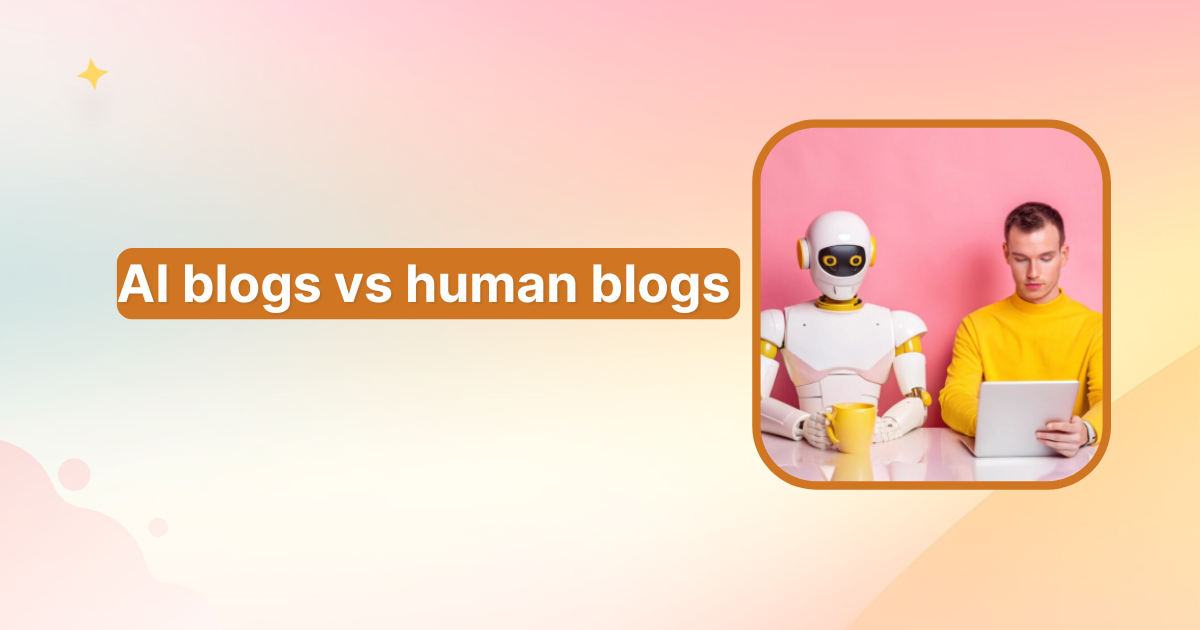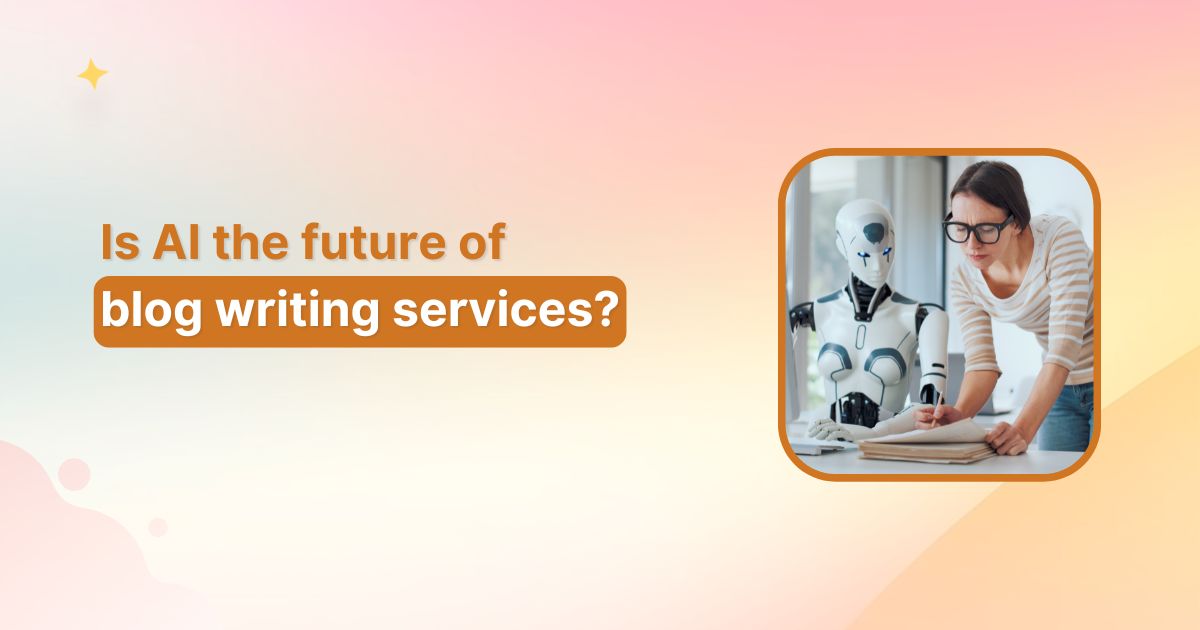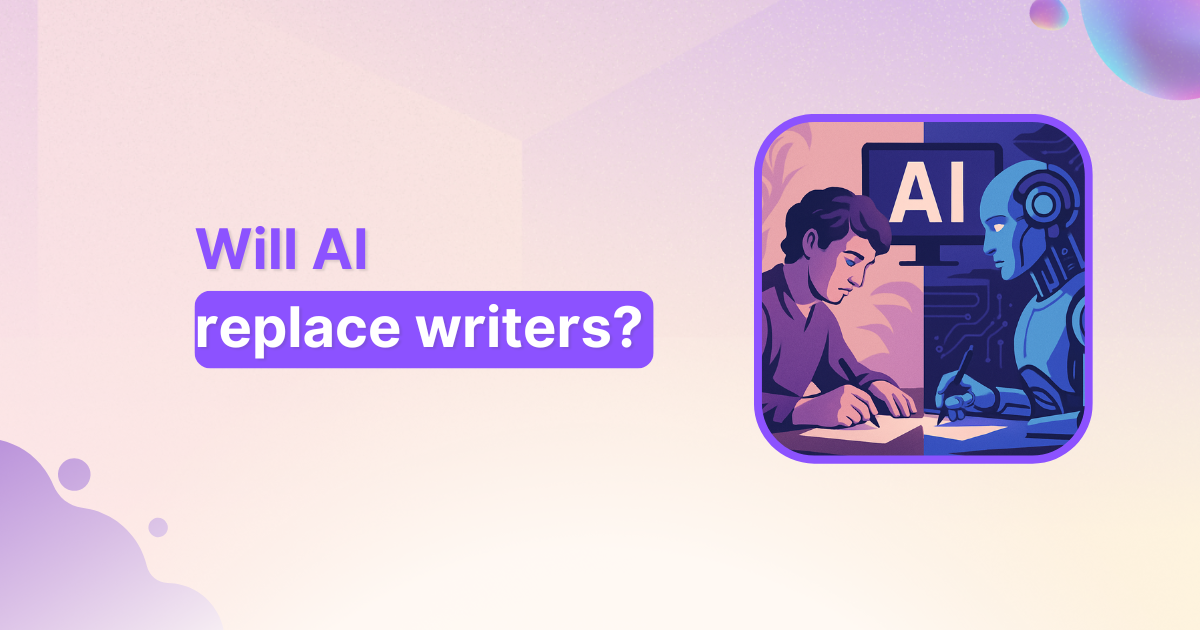AI blogs vs human blogs: Which creates better content in 2025?

The debate between AI blogs vs human blogs has reached a tipping point. With AI tools for content creation becoming more popular and advanced, businesses are questioning whether they should stick with human writers or embrace artificial intelligence for their content strategy.
Studies indicate that 88% of marketers are already relying on AI to handle day-to-day tasks. Moreover, it is noted that most people are unable to differentiate between AI-generated and human-written content.
This raises an important question: Which approach between AI writing vs human writing actually delivers better results for your blog?
In this comprehensive comparison, we’ll explore the key differences between AI-written content quality and human blog writing to examine their strengths and weaknesses. It will help you determine the best approach for your content strategy in 2025.
What is an AI-generated blog?
An AI-generated blog is content created using artificial intelligence tools that can research, write, and optimize articles with minimal human intervention. These tools use advanced language models to understand context, analyze search intent, and produce coherent, engaging content.
The concept of AI blog writing became streamlined with ChatGPT, where users can just enter a few prompts and get a complete AI-generated blog. However, now specialized AI blog writers online like Contentpen are also available that go much beyond simple text generation.
They can conduct SERP analysis, understand brand voice, and create content that is specifically optimized for search engines while maintaining readability and engagement.
Interesting fact: According to Ahrefs’ study, 74% of new webpages include AI content. It means a massive majority of content writers, marketers, and website owners are already using AI to generate website copy and blog posts.
What is a human-written blog?
A human-written blog is content created entirely by human writers who bring personal experience, creativity, and emotional intelligence to their work. These writers conduct research, develop unique perspectives, and craft content based on their understanding of the audience and subject matter.
Human writers excel at storytelling, injecting personality into content, and creating emotional connections with readers. They can draw from personal experiences and adapt their writing style based on feedback and changing trends.
AI blogs vs human blogs: Key differences
The following table summarizes the key differences between AI blogs vs human blogs
| Aspect | AI-generated blogs | Human-written blogs |
| Speed | Can create 4,000+ word articles in 10-15 minutes | Takes 6-12 hours for detailed articles |
| Consistency | Maintains consistent quality and tone across all content | Quality can vary based on the writer’s mood, experience, and workload |
| SEO optimization | Built-in SEO features with automatic keyword integration | Requires manual SEO optimization and keyword research |
| Cost | $10-50 per article, depending on the tool Tip: You can get an article for $2.7 only with Contentpen’s annual plan. | $100-500+ per article for quality writers |
| Scalability | Can produce unlimited content simultaneously | Limited by human capacity and availability |
| Research depth | Instant access to vast information databases | Deep, nuanced research with critical thinking |
| Factual accuracy | Requires fact-checking for current events | Better at contextual accuracy and real-world validation |
| Brand voice | Consistent brand voice once trained | May require ongoing guidance for brand alignment |
| Editing required | Minimal editing for grammar, moderate for style | Extensive editing for structure, flow, and optimization |
Choosing an advanced AI blog generation tool
When evaluating AI writing tools for your content strategy, certain features separate basic text generators from sophisticated AI blog writing platforms.
Here are the key capabilities that define next-generation AI content creation:
Multi-agent architecture for superior quality
The most advanced AI writing platforms don’t rely on a single AI model. Instead, they deploy multiple specialized AI agents working in coordination. The goal of these AI agents is to handle multiple tasks like research, outline creation, writing, SEO optimization, and quality review. This collaborative approach produces significantly higher quality output than traditional single-model tools.
Intelligent brand voice integration
Generic AI content often sounds robotic because it lacks brand context. Advanced tools analyze your existing content, website, and competitors to understand your unique voice and audience. This brand knowledge system ensures every piece of content aligns with your brand identity rather than producing disconnected, generic text.
Complete SEO automation
Modern AI writing tools go beyond basic keyword stuffing. They automatically integrate keywords naturally, generate optimized meta descriptions, structure content for featured snippets, and even handle internal and external linking strategies. This automation saves hours of manual SEO work while ensuring better search performance.
End-to-end workflow automation
The best AI platforms streamline your entire content process. Features like bulk content generation, editorial workflows, and direct publishing capabilities allow you to create a blog in 10 minutes from initial keyword research to a published article.
Human-level content quality
Advanced AI tools incorporate sophisticated review systems that check for coherence, factual accuracy, and editorial standards. The output often requires minimal editing and can match the quality of professional human writers, making it difficult for readers to distinguish between AI and human-generated content.
These features represent the current state-of-the-art in AI content generation. Contentpen is the leading AI writing tool that has successfully integrated all these capabilities into a unified platform that addresses the real challenges businesses face when scaling their content strategies.
Here’s a complete tutorial on how you can generate a complete blog post using AI:
How to choose between AI vs human writers for your blog strategy?
The choice between AI and human writers isn’t always binary. Here are key factors to consider:
Choose AI writing when:
- You need to scale content production quickly
- Budget constraints limit hiring multiple writers
- You’re targeting competitive keywords requiring frequent content updates
- Your content strategy focuses on informational rather than highly creative topics
- You need a consistent brand voice across large volumes of content
Choose human writers when:
- Creating thought leadership content requires unique perspectives
- Writing about sensitive topics that require emotional intelligence
- Crafting content for high-stakes campaigns or major announcements
The hybrid approach: Many successful businesses combine both approaches. Use AI for foundational content creation and human writers for refinement, fact-checking, and adding personal touches. This approach can significantly cut your blogging time while maintaining quality.
Can AI and human writers work together?
Absolutely. The most effective content strategies in 2025 use both AI efficiency and human creativity. Here’s how this AI blogs vs human blogs collaboration works:
AI handles the heavy lifting:
- Initial research and data gathering
- First draft creation and structure
- SEO optimization and keyword integration
- Fact compilation and source identification
Humans add the finishing touches:
- Personal anecdotes and unique insights
- Emotional resonance and storytelling
- Final quality review and brand alignment
- Strategic positioning and thought leadership
Step-by-step AI-human collaboration workflow using Contentpen
Let’s take a closer look at how you can establish a perfect AI-human content collaboration workflow with Contentpen:
Step 1: AI-powered research and planning
Start by letting AI analyze your target keywords, competitors, and audience intent. Contentpen can conduct a comprehensive SERP analysis to identify content gaps and opportunities. This research phase, which traditionally takes hours, can be completed in minutes while providing deeper insights than manual research.
Step 2: Intelligent outline generation
AI creates a data-driven outline based on what’s currently ranking, user search intent, and your brand positioning. The outline includes optimal heading structures, keyword placement strategies, and content flow recommendations. This ensures your content addresses all relevant subtopics while maintaining logical progression.
You can edit the AI-generated outline as per your own understanding before creating the actual article. This is a crucial stage where you can add your own creativity through human intervention.
Step 3: Content creation with specific brand voice
The AI generates a comprehensive draft that incorporates your brand voice, integrates keywords naturally, and follows SEO best practices. You don’t have to treat this draft as the final product. Instead, it is recommended that you further enhance it.
Step 4: Human enhancement and collaboration
This is where human creativity shines. Writers add personal experiences, industry insights, and emotional elements. Moreover, you can refine the tone, add storytelling elements, and ensure the content resonates with the target audience on a deeper level.
You can also use the platform’s built-in collaboration features, so teams can review, edit, and optimize content in real-time. The AI continuously suggests improvements for SEO, readability, and structure while humans focus on strategic messaging and brand alignment.
Step 5: Quality assurance and publishing
Final review combines AI-powered fact-checking and SEO optimization with human editorial judgment. The content is then published directly through integrated CMS connections, with performance tracking beginning immediately.
Real-world implementation example
Consider how a SaaS company might use the AI blogs vs human blogs workflow for a competitive analysis article:
- AI research: Analyzes top 20 competitors, identifies 50+ comparison points, and creates feature matrices
- Human insight: Adds strategic perspective on market positioning and customer pain points
- AI writing: Generates structured comparison tables, feature descriptions, and SEO-optimized sections
- Human enhancement: Adds case studies, personal recommendations, and industry commentary
- Collaborative editing: Team refines messaging while AI optimizes for search performance
This approach allows the company to produce detailed and authoritative content in 1-3 hours instead of the 8-12 hours required for fully manual creation, while maintaining the strategic depth and personal touch that drives conversions.
The key to success is choosing platforms that support this collaborative workflow seamlessly. Tools like Contentpen offer integrated environments where AI generation, human editing, team collaboration, and publishing all happen within the same dashboard, eliminating the friction that often derails hybrid content strategies.
Final thoughts: AI blogs vs human blogs
The future of blogging isn’t about choosing between AI blogs vs human blogs, it’s all about finding the right balance for your specific needs and goals. AI writing assistant tools like Contentpen are rapidly closing the quality gap while offering unprecedented efficiency and scalability.
As we move forward, the most successful content strategies will be those that use AI’s efficiency while preserving the creativity and emotional intelligence that only humans can provide. The key is choosing the right tools and approach for your unique situation.
So, are you ready to experience the power of advanced AI blog writing? Start your free trial with Contentpen and discover how multiple AI agents can transform your content strategy while maintaining the quality your audience expects.
Frequently asked questions
No, Google doesn’t penalize AI content specifically. Google’s focus is on content quality, not the method of creation. Well-crafted AI-written content quality that provides value to readers and follows SEO best practices performs just as well as human-written content.
AI blog writers are platforms designed specifically for creating complete blog posts from research to publishing. AI writing assistants are broader tools that help with various writing tasks like editing, brainstorming, and content improvement. Blog writers focus on end-to-end content creation with AI, while assistants support existing human writing processes.
Modern AI blog vs human blog writing comparisons show that advanced AI tools can match human quality for informational content, while humans still excel at creative storytelling and emotional connection. The quality gap is narrowing rapidly, with AI often producing more consistent, SEO-optimized content, while humans bring unique perspectives and industry expertise.
Advanced AI blog writers can learn and replicate your brand voice by analyzing your existing content, style guides, and preferences. The brand voice feature in sophisticated tools ensures consistency across all generated content, moving beyond generic AI output to brand-specific writing.
This varies significantly by tool quality. Premium AI writing tools typically require minimal editing, usually just final review and any brand-specific adjustments. Properly editing AI content can be done in 15-20 minutes versus hours for human-written first drafts.
Absolutely. AI writing tools excel at overcoming writer’s block by providing outlines, generating ideas, and creating first drafts. They’re particularly effective as AI writing assistants that help break through creative barriers and provide structure for human writers to build upon.
Yes, modern SEO-friendly blog writing tools automatically optimize for keywords, create meta descriptions, and structure content for search engines. They can analyze SERP data, identify content gaps, and optimize for featured snippets. You can also enhance results with dedicated SEO writing tools for complete optimization.
You might be interested in...

Is AI the future of blog writing services?
Traditional blog writing services face their biggest disruption yet. With generative AI tools producing content in seconds, businesses are questioning whether they still need human writers. AI writing tools have transformed from niche curiosities to mainstream business solutions practically overnight. Content agencies report a common refrain from clients: “Why should we pay for human writers […]
Aug 5, 2025

AI blogs vs human blogs: Which creates better content in 2025?
The debate between AI blogs vs human blogs has reached a tipping point. With AI tools for content creation becoming more popular and advanced, businesses are questioning whether they should stick with human writers or embrace artificial intelligence for their content strategy. Studies indicate that 88% of marketers are already relying on AI to handle […]
Jul 14, 2025

Will AI replace writers? The truth behind the hype
The digital landscape is buzzing with excitement and anxiety about AI writing tools. From Contentpen’s intelligent content generation to ChatGPT’s conversational prowess and Jasper’s marketing copy expertise, artificial intelligence has stormed into the writing world with impressive capabilities. This technological leap forward has sparked a burning question that keeps writers awake at night: Will AI […]
Jun 19, 2025